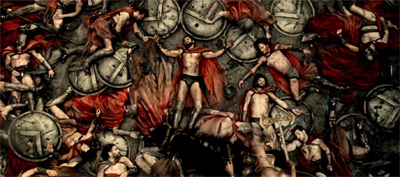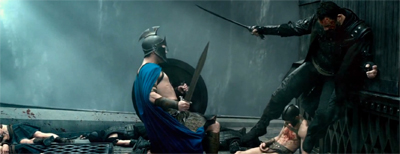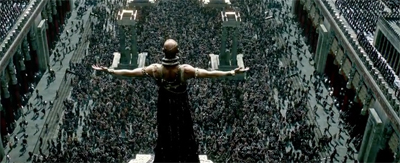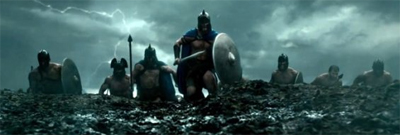It is almost immediately apparent that 300: Rise of an Empire was not directed by Zack Snyder. Snyder is credited on the inter-quel’s screenplay, but Rise of an Empire is directed by Noam Murro. Murro’s only other feature-length directorial credit is the forgotten indie movie Smart People, which would hardly make a case for Murro as an obvious choice to succeed Snyder in the director’s chair.
300 was a lavish and rich (and surprisingly shrewd) visual feast – packed with iconic imagery and memorable mosaics, treating it’s muscle-bound stars as props for epic spectacle while casting a knowing look out at the audience. Rise of an Empire feels like an attempt at imitation rather than innovation – with a sense that Murro isn’t bold enough to put his own stamp on the film, instead trying to channel one of the most unique voices currently working in action movies.
On a purely visual level, 300 was a feast. Like its contemporaneous Frank Miller adaptation, Sin City, it was a movie with a clear artistic vision and a distinctive voice. The picture was heavily stylised, looking unlike anything that had been produced before. If we are to be brutally honest, 300 still looks distinct – even amid the sea of imitators and copycats that have tried to capitalise on the success of that most unlikely cinematic blockbuster.
Rise of an Empire comes a lot closer than most of those imitators to capturing Snyder’s approach to the material. Murro provides a number of effective visuals and stunning CGI-rendered spectacles. He is very good at doing “Xerxes surveys his kingdom” shots, with two of the movie’s more memorable moments coming from shots of Xerxes looming over his dominion, cape billowing beneath him, creating the impression that the Persian is somehow part of the terrain itself. The opening shot of a sculpture morphing into a haunting still image is also effective and eye-catching.
Sadly, too much of Murro’s work feels like a lifeless imitation of Snyder. This is most obvious when Murro tries to work with the imagery that Snyder used so effectively. Given the overlap between 300 and Rise of an Empire, that’s a considerable portion of the film. The hunchback traitor Ephialtes, for example, was rendered as a grotesque horror by Snyder. Under Murro’s camera, he feels like a generic character under several pounds of make-up. Snyder made the Persian Immortals seem ethereal and otherly, genuinely unsettling and unnerving. Murro reduces them to generic baddies, even giving them some broad comedy to play.
It is worth noting that Rise of an Empire seems to go out of its way to mitigate some of the criticism levelled at its predecessor. The decision to reduce the ethereal and haunting presentation of characters like Ephialtes and the Immortals might have been a conscious effort to tone done some of the more uncomfortable aspects of 300, a film frequently attacked for being racist or culturally insensitive.
In response to allegations accusing the film of racist portrayals of the Persians, Rise of an Empire seems to try to compensate. Xerxes, with his gold chains and strange proportions, is presented as a marked oddity – particular in contrast to the more “human” looking Persian characters around him. His father, Darius, looks like a fairly normal person. The primary antagonist of the film is a Greek woman named Artemisia – and her back story exists to assure viewers that the Greeks could be just as monstrous as the Persians they face. The Immortals are no longer walking monsters, but simply gimmick henchmen.
This has a somewhat paradoxical effect. In toning down the exaggeration of the portrayal of the Persians, there’s a sense that Rise of an Empire is trying to ground itself. The original 300 was told through a framing device – inviting to witness the conflict as seen through the eyes of Dilios, the Spartan storyteller. Of course it was jingoistic and xenophobic, as it was essentially a piece of propaganda told by a society that deemed it “civilised” to send their children into the wild and who kept their own slaves and practised many of the hedonistic actions they accused the Persians of perpetrating.
In short, the racial subtext of 300 felt deeply ironic – as if trusting the audience to realise that Dilios’ narrative might just be a little self-serving and manipulative. While Snyder may not be the strongest storyteller working in contemporary Hollywood, he has a knack for irony. After all, Man of Steel reads as well as a condemnation and criticism of its protagonist as an ode to Superman. It seems even more cynical and bitter than Superman Returns. Singer’s film simply suggested Superman was terrifying and truly alien on an interpersonal level, while Snyder suggested that Superman was a horrifying concept on the broadest possible scale.
Although one can see traces of that irony in Snyder’s script for Rise of an Empire. For all the rhetoric about protecting democracy, our first visit to Athens suggests (correctly) that Athenian democracy was hardly an ideal. However, there’s a sense that Murro lacks the technical craft to carry off that sort of self-aware subversiveness. Snyder’s script frames Rise of an Empire as a story recounted to Spartan soldiers on their way to war, but this isn’t a clever self-aware storytelling device in the way that Dilios’ narration was.
Instead, the narration feels a little surreal and pointless. We spend considerable time listening to stories within stories. At one point, a character tells another character about the very first part of the story, and so we end up getting a flashback (complete with a repeat of the slow motion “noooooo!”) within our flashback. This doesn’t seem clever or self-aware or even playful. It just feels like a muddle.
While 300 kept most of its narrative focused on Leonidas, Rise of an Empire is too diffuse to work as a single story told about a single viewpoint of one event. Although the story is told by the Spartans, it doesn’t feel anchored to their perspective. We take a trip to Persia to attend to Xerxes’ secret origin, at one point. There are several extended sequences that unfold where it’s hard to imagine our narrator could have gleaned the second-hand information.
Throughout the story, the Athenian values of “democracy” and “freedom” are taken at face value and presented as unquestionable absolutes. This would make sense if the Athenians were telling the story – if they were crafting the narrative in their own relativist terms – but the movie goes out of its way to inform us that the Spartans have little time for these concepts. So it seems weird for a story being told to Spartans by Spartans espouses a central viewpoint so firmly anchored in the perspective of their rival city-state and grudging ally.
So, in short, there is no defence for the more awkward aspects of Rise of an Empire, with the movie lacking the clever self-awareness that disarmed so many of the criticisms about 300. There are points where it seems like Murro might be cleverly making a subversive point. During an Athenian speech about freedom, we cut to the slaves powering the ship. However, that’s just dodgy editing. The slaves are being exploited by the Persians, with little acknowledgement of the fact that Athenian democracy was only a good thing if you you were a free male land-owner.
(This makes some of the movie’s more clumsy stabs at contemporary imagery feel a little ham-fisted. At one point, the Athenian fleet find themselves under attack from suicide bombers. The political and racial subtext is uncomfortable, to say the least – and it feels far more unsettling than any of the exoticism at play in the original 300.)
One of the more interesting aspects of Rise of an Empire is the fact that it is loosely based on Frank Miller’s long-delayed Xerxes novel. It remains incomplete at the time of writing. Given Miller’s tendency to wander away from projects that have ceased to hold his interest, it’s hard to know if the comic will ever be fully published. Given that it has not been released, it’s hard to know how much (if any) of Rise of an Empire is rooted in Miller’s writing. However, the script does make use of some of Miller’s less-than-endearing storytelling tropes.
In many ways, Eva Green’s Artemisia feels like the archetypal Frank Miller female character. Artemisia is defined as brutal and violent, but also as a victim of past sexual trauma. One of the more frequent criticisms of Miller’s writing, at least before 9/11, was that there was an uncomfortably sexist undertone to his work. This is most obvious in stories like Sin City or Batman: Year One. Artemisia’s origin by rape feels like particularly tasteless bit of character back story, thrown out so casually and with little real consideration.
It’s a shame, as Green does great work here. Green gives the best performance in the film as the movie’s nominal villain – a character waging a one-woman war against Greece and refusing to yield, while propping up and maintaining the throne of a male character. It’s not the most nuanced or developed of roles, but Green relishes the opportunity to ham it up, and to chew on the scenery. As with Dark Shadows, there’s a campy enthusiasm to her performance that is almost endearing.
As such, it’s disappointing that none of the rest of the cast really distinguish themselves. The role of Leonidas might not have demanded much, but Gerard Butler was ideally suited to playing an alpha-male jock in a red cape and a leather diaper. Sullivan Stapleton lacks that sort of screen presence, and Themistokles feels particularly one-dimensional. It’s always great to see Lena Headey, but her work here seems almost phoned in – along with most of the other cameos the film could muster from actors who appeared in 300.
There is something very interesting about the structure of Rise of an Empire. Hollywood franchises are fairly reliable machines, but it seems like they have changed quite a bit in recent years. In the old days, a popular film would earn a sequel. Spin-offs were rare, but they did happen. Only in the last few decades did prequels really take off as a credible avenue for film development, along with reboots. So this film feels a little strange.
Rise of an Empire is very much a “side-quel“ to 300. It is both a prequel and a sequel to the film – it spans events leading up to the invasion of Greece by the Persians and picks up after the credits rolled on the first film. However, a significant portion of events unfold in parallel with the events of 300. Apparently Leonidas wasn’t the only Greek throwing Xerxes a “welcome to Greece” party. So there’s a significant overlap between the films, with several scenes from Rise of an Empire slotting neatly between scenes in 300. In that respect, it’s not unlike The Bourne Legacy.
This is by turns intriguing and frustrating. It’s frustrating, because the constant clips of Leonidas and his own last stand create a sense that we are only watching half of a film – and the weaker half at that. However, it’s also intriguing, because it manages to create a sense of a cinematic world that is much larger than a single two-hour film. It creates a sense that these characters live in a world where things happen outside their control, if only because there’s another story unfolding nearby. Like The Bourne Legacy, this is more unsatisfying than it is fascinating, but it does offer a demonstration of how franchises are evolving.
Rise of an Empire can’t help but feel like an imitation of a superior film – an attempt to copy a movie that was so effective and so charming because it felt utterly unlike anything the audience had really experienced before.
Filed under: Non-Review Reviews | Tagged: 300, 300: rise of an empire, athenians, empire, eva green, frank miller, greece, greek, lena headley, leonidas, Movie, non-review review, persians, racism, review, rise of an empire, sexism, Spartans |































“After all, Man of Steel reads as well as a condemnation and criticism of its protagonist as an ode to Superman. It seems even more cynical and bitter than Superman Returns. Singer’s film simply suggested Superman was terrifying and truly alien on an interpersonal level, while Snyder suggested that Superman was a horrifying concept on the broadest possible scale.”
I rechecked your review of Man Of Steel, and am still not sure why you thought MOS’s take on Superman was (or could be) that he was a “horrifying” concept. What part of the movie dwelled on that? If you don’t mind the off-topic tangent.
Hi Chris.
I could have sworn it was in there, but I checked and it wasn’t. (Although there was some weird spacing towards the end, suggesting perhaps I’d cut a paragraph or two. I may have trimmed it to spare readers some spoilers. Either way, I’ve added it back now.)
Basically, it’s the climax of the film, which really sort of seems to be a cautionary tale about how absolutely horrifying combat between Superman and his villains would be. It’s the Battle of Metropolis from the climax of Superman II played devastatingly straight, with Metropolis’ civillians caught in the crossfire of a battle on a scale that is almost beyond their capacity to comprehend.
Superman and Zod fly through buildings, topple structures and cause an almost unfathomable level of damage. While Superman defeats Zod and saves Earth, it’s hard to parse something on this scale as anything other than the most Pyrrhic of victories. So it seems to present the idea that Superman really is something to be a bit wary of, even as you’re in awe of him. It’s a much more interesting and intriguing subversion than Superman-as-deadbeat dad as in Superman Returns.
Amazing review, I do share many of your feelings. I felt a general distance for the obvious attempt of the movie to both imitate and straying from the original movie by “watering down” the most problematic elements.
While Miller’s body of works contains undoubtly problematic themes and subtexts, it alwasy disconcerns me that people accuse him of bigotry and homophobia for works like 300 when it’s clear the entire piece is a propagandistic tale told by the spartan’s point of view. It’s a simplistic view on the author’s career. One can acknowledge his numerous flaws without the need to paint him as a lunatic.
Great work.
He’s not lunatic, he’s Islamophobic radical Zionist, pretending to care for America with rhetoric in FOX News fashion !
By the way, haven’t you seen, it was his signature in lower right corner on Benji “Red-line bomb” shown at UN GA ?!
Good review yo, I just saw this film yesterday and I poretty much thought it was alright, but nothing to right home about. The action was cool, but the amount of slow motion was absurd, I swear the majority of the film was in slow motion. As for the cast the only person I really liked was Lena Headey, but that’s probably due to her character in Game of Thrones. Eva Green was good, but I couldn’t really take her seriously because the performance was a bit over-the-top and her fight scenes weren’t as hardcore as her younger counterpart.
Mad Max get kicked out of Holly(land)wood for “Passion”, while this ultra-xenophobic, Islamophobic, orientalistic, rant by one (maybe both) racist get celebratory “hall of fame” respond worthy of cult film.
Bravo, and dear Jebus help us, for what a screwed hemisphere, “western” that is, we live in !
O-kay.
I was under the impression that Mel Gibson was ostracised for his racist rants and off-screen behaviour. I thought Passion was well-received commercially, which would hardly have made him persona non grata around Hollywood.
When you say “both” racists, are you attacking Snyder? I haven’t seen any statements made by Snyder that I would consider racist, but I stand open to correction. (That said, he doesn’t seem to present himself particularly well in interviews, so I wouldn’t be too surprised to find some cringe-worthy statements.)
However, even if we accept that Frank Miller is racist and Islamophobic – an argument I’m not really that interested in having, as I think his statements speak for himself and I don’t think too many would disagree that Miller has serious issues – that doesn’t mean that the films are.
After all, does the deplorably off-screen conduct of Roman Pulanski make Chinatown a pro-sex-abuse film? (The same is arguably true of Woody Allen, who is yet to be proven guilty.) Bad people can make good art.
(And the comparison is not accidental, Chinatown depicts sexual abuse much as 300 depicts xenophobia. However, it would require a rather simplistic reading to suggest that the films are unequivocally “pro” these things just because of associations made by their creators.)
Simplistic reading ?
Really, for incredibly overt and straightforward contemporary ideological, political and war propaganda comic/film !?!
Entire German art establishment reviewed, discussed moralized and rationalized Hippler-Taubert “art-film” with much-less the same arguments, and barely any of them rejected it as they should, as peace of trash, motivated by political and ideological stance of artist and his worldview for contemporary political and military usage, conceived only as a mean for creating atmosphere in which accepted racism, mythomania and chauvinism can thrive, and public tamed and recruited when the killing starts !
But, as you said, you are not interested for debating authors motives, which leave us with nothing to debate in case of Miller-Snyder work on “300”!
(Just in case you are interested, after all, try with scholarly and complex dismantling of this “complicated/multilayer/hyper-symbilc” peace of kitsch, that you nonchalantly compared to Chinatown, with Racialicious as starting point:
http://www.racialicious.com/2009/02/27/frank-millers-300-and-the-persistence-of-accepted-racism/).
Cheers!
I’ve read that article. I’ve read a lot of coverage of 300.
While I respect those opinions, I don’t agree with them – and I resent the thinly-veiled suggestion that I must be racist or homophobic or anything like that because I don’t agree with them. (Not that I am suggesting you are implying such a thing; it’s just a pervading sense I get when I engage in discussions on the matter – “your opinion is wrong and must be shouted down, because myself and people who think like me are the only people who understand what this art is really about.”) I also note there are no comments open on the article to encourage or foster debate.
When I “nonchanlantly” compared it with Chinatown, it was not in terms of quality; it was in the context of this debate. Both are works of art produced by controversial figures. Frank Miller has made some xenophobic comments, and some other offensive statements; Roman Polanski raped a child. The films in question are compared because they arguably reflect back those themes. 300 is essentially about propaganda and myth-making; while Chinatown is (partially) about long-term rape and abuse of a young girl by an older man (in this case, her father).
However, we can accept that Chinatown does not offer a defence of Polanski’s conduct, because that’s an absurd argument. And yet, 300 is treated as an embodiment of all those racially-charged statements that Miller has made. The film is indicted based on the attitudes of one of the people involved in its production well over a decade ago. (Miller was far more involved in the cinematic production of his Sin City comics.)
When I say “simplistic”, I mean because it takes the film’s propaganda at face value. It’s akin to suggesting that every film featuring “the n-word” must be racist.
300 is framed as a story told by the Spartans to the Spartans. It is told by a one-eyed man, a character literally without any depth perception. The Spartans are introduced as a bunch of people who think it’s a good idea to send children into the wild to fend for themselves and kick messengers into their drinking water. Of course the story told by the narrator is racially-charged and one-sided, because that’s the entire point. 300 is a demonstration of how these sorts of myths get started, and how propaganda works. It’s not the death of Leonidas that unites Greece against the Persians, it’s the racist propaganda myth built up around him. It is even heavily visually stylised, which is cinematic shorthand for “what you’re seeing here is not meant to be taken literally.”
But, you have your opinion, and I have mine. I’ll respect yours as long as you respect mine. Doctors differ and patients die. Film nerds on the internet disagree and life goes on.
And something on artists and art – one of the greatest writers of “my tribe”, Danilo Kiš, once said “First tell me your opinion about Holocaust and then we can talk of anything”.
(He never mentioned anything about sexism or homophobia in this context.)
But, by that logic, would that mean that Roman Polanski’s art should never be talked about? That Mel Gibson’s work does not merit mention? If you start ruling out art produced by people who hold controversial opinions or have done unforgivable things, then you narrow the pool considerably. Logically, any film produced before – to pick an arbitrary date – 1980 probably had somebody who was homophobic working on it, so should we throw all that stuff out too? (You also risk wandering into the realm of “only people who think like me should be allowed to express themselves”, which is also problematic.)
( this should goes to as reply to > Darren, on March 17, 2014 at 9:27 am said: < )
No, by this logic art motivated by murderous/genocidal ideology, which seeking for the adequate modus to rationalize calls for "total war", and/or when actually becomes fascist, chauvinist, xenophobe, religious bigot and hatemonger ideological tool, which he use to entertain masses to the point in which they are ready to accept reality when the killing starts, is in NO way same as Polanskis' sexism – rape of 17yrs. old child and mental drill for the masses to cheerfully accept call for Total War can hardly constitute valid analogy .
On the other hand it could be on the same wavelength with Mad Max religious (Christian) overdose, which with proof and right arguments could easily be interpreted as antisemitism, however I'm not sure that he was allowed, or that he ever had any chance within political and ideological framework of his environment (Hollywood, US, most of the western world) to use his art in a same way and same result and consequences as these two (three) peace of dirt (Miller-Snyder (Noam M.) did !
Cheers!